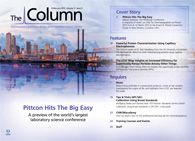Green Tea Analysis Using UHPLC–QqQ–MS–MS
A QuEChERS-based ultrahigh-performance liquid chromatography triple quadrupole tandem mass spectrometry (UHPLC–QqQ–MS–MS) method was used to determine pesticides in nutraceutical products from green tea (Camellia sinensis),
Volume 11 Issue 2
Pages 2-6
A QuEChERS-based ultrahigh-performance liquid chromatography triple quadrupole tandem mass spectrometry (UHPLC–QqQ–MS–MS) method was used to determine pesticides in nutraceutical products from green tea (Camellia sinensis), according to a study published in the journal Food Chemistry.1
Green tea is produced from the steamed fresh leaves of the Camellia sinensis plant. It is said to have a range of health benefits and is rich in antioxidants. Nutraceutical products are derived from food sources, such as green tea, which are said to provide extra health benefits.
The team performed extraction with acidified acetonitrile (acetic acid 1% [v/v]); no further clean-up steps were required. Approximately 100 pesticides in nutraceutical products were determined using UHPLC–QqQ–MS–MS. Recoveries ranged from 70% to 117% and relative standard deviation (RSD) was lower than 20% at concentration levels of 25 μg/kg, 50 μg/kg, and 100 μg/kg for intraâday precision and equal or lower than 25% for inter-day precision. Limits of quantification (LOQ) were equal or lower than 25 μg/kg. The total run time was 11 min.
The method was applied to commercial nutraceutical products, and detected acetamiprid at 56 μg/kg and carbendazim at 13 μg/kg in two samples. - K.M.
Reference
Gerarddo Martinez-Dominguez, Antonio Jose Nieto-Garcia, Roberto Romero-Gonzalez, and Antonia Garrido Frenich, Food Chemistry177, 182–190 (2015).
This article is from The Column. The full issue can be found here>>

New Study Investigates Optimizing Extra-Column Band Broadening in Micro-flow Capillary LC
March 12th 2025Shimadzu Corporation and Vrije Universiteit Brussel researchers recently investigated how extra-column band broadening (ECBB) can be optimized in micro-flow capillary liquid chromatography.







